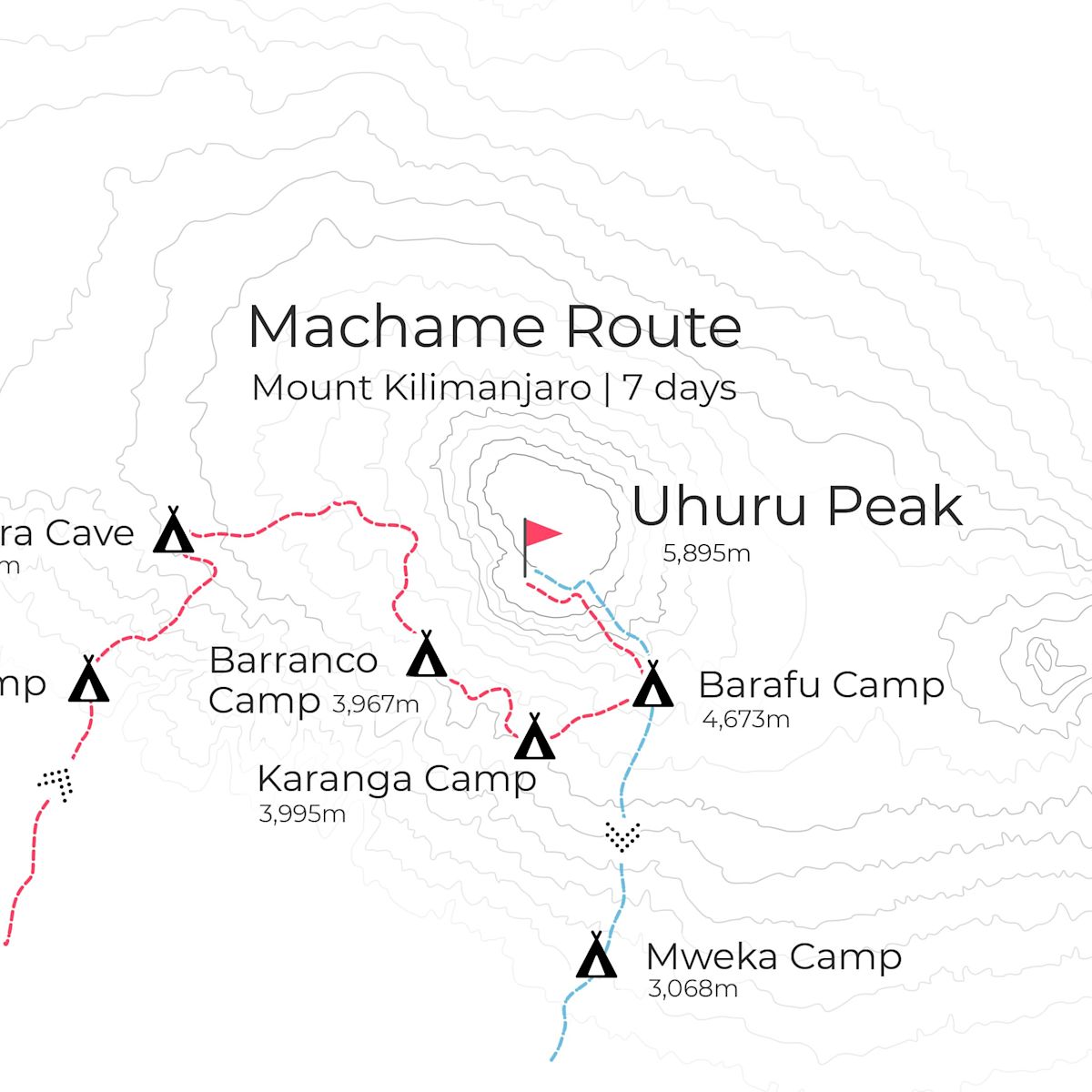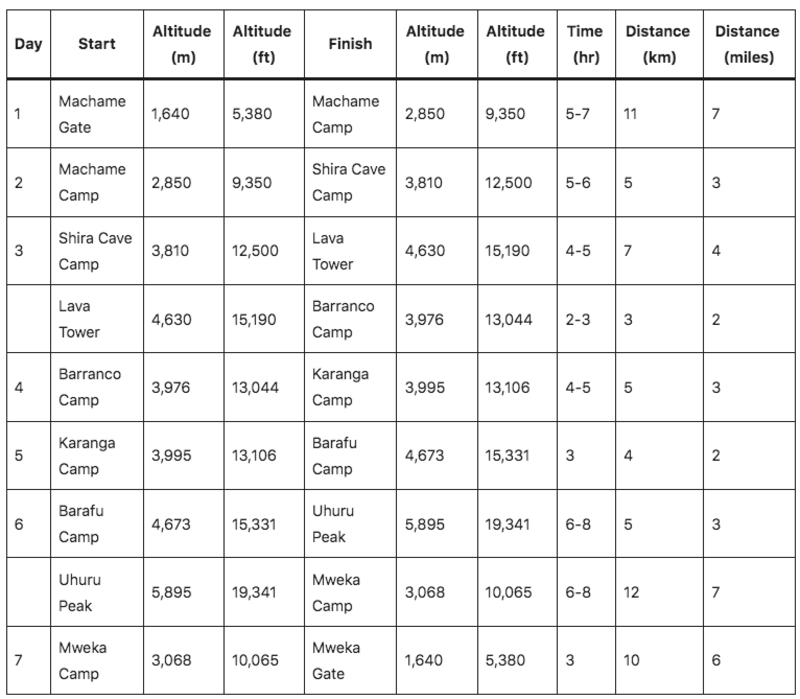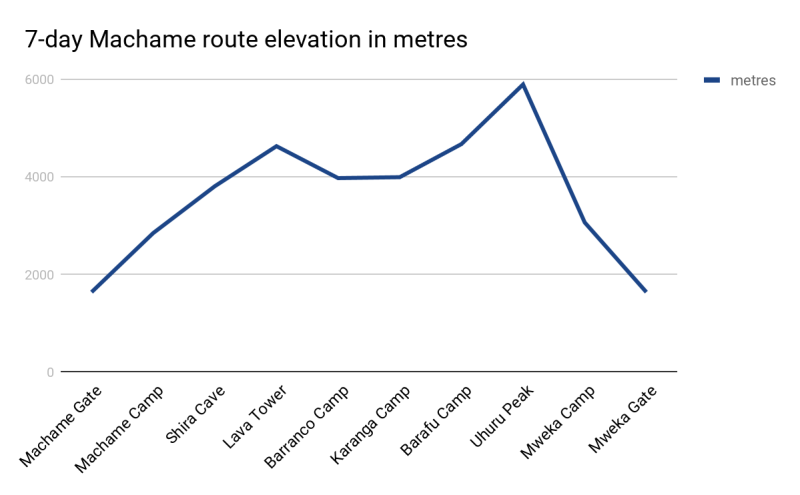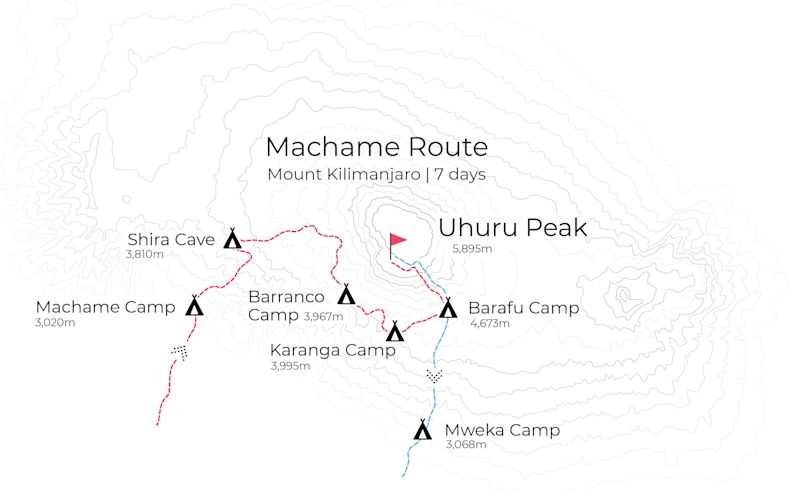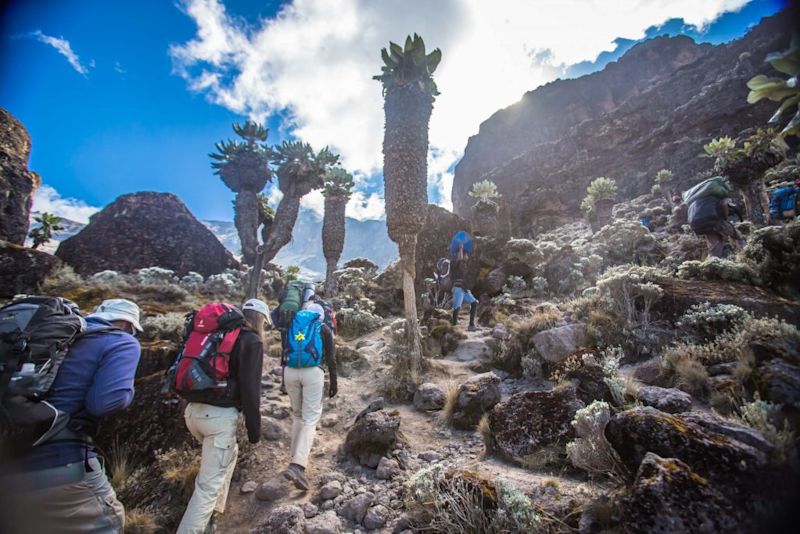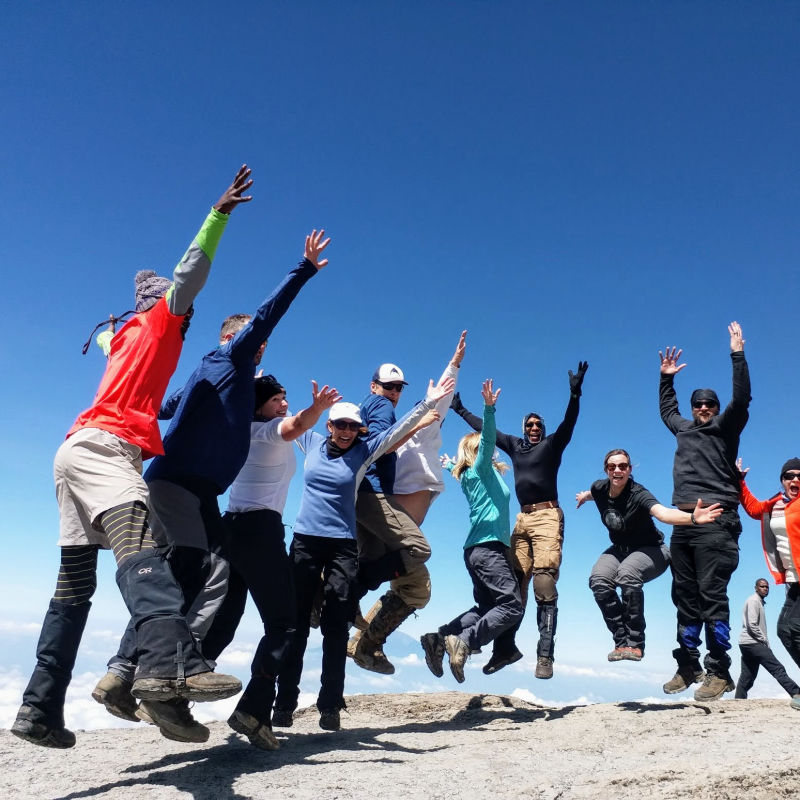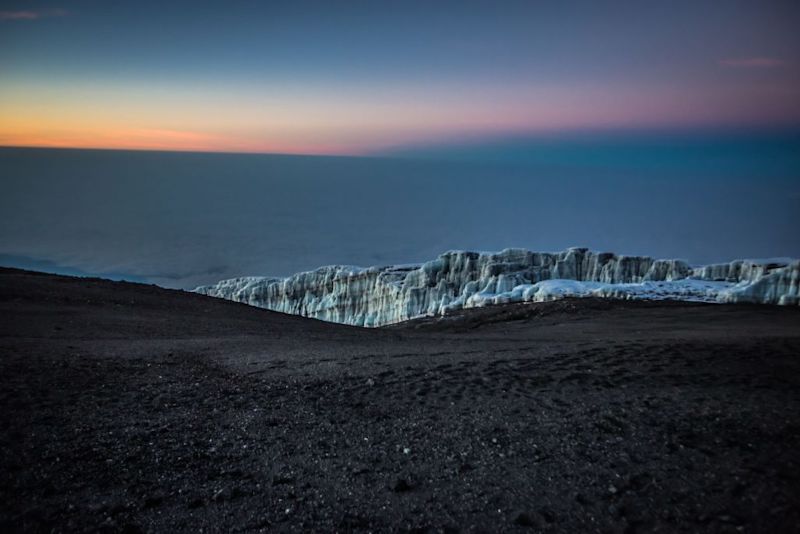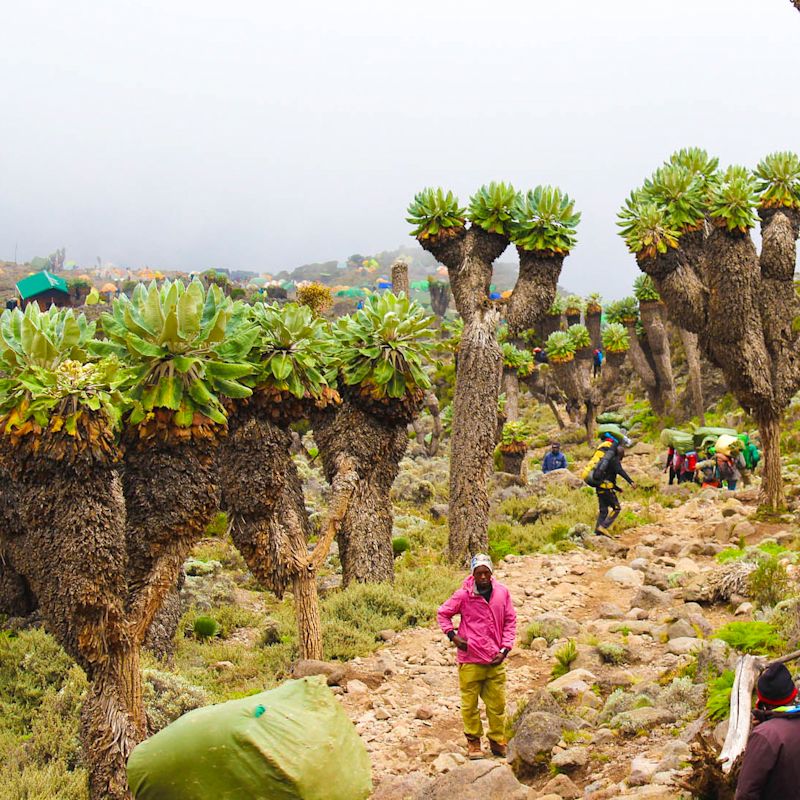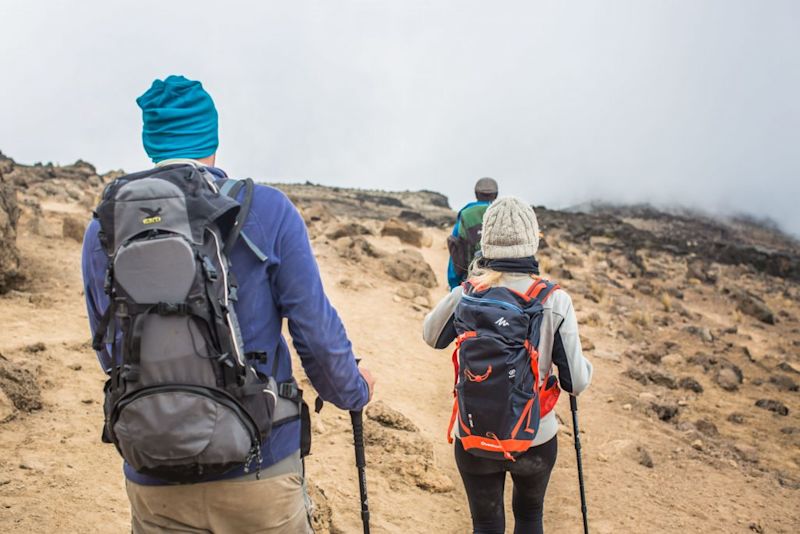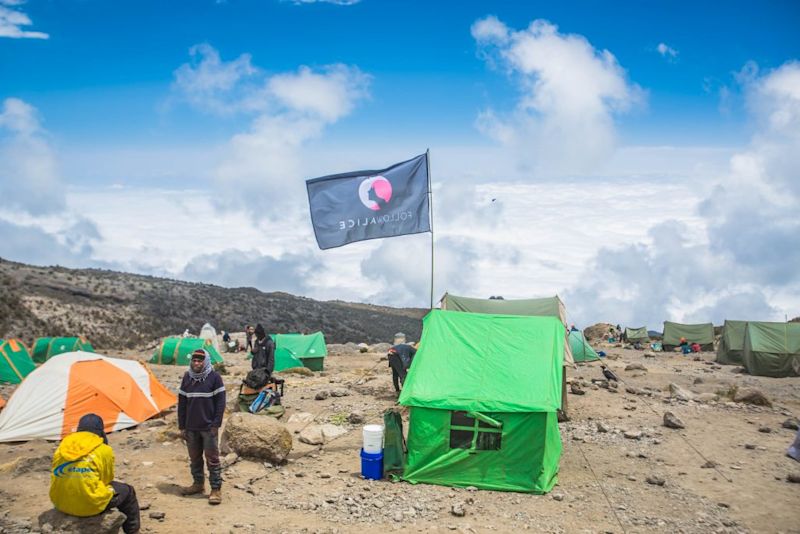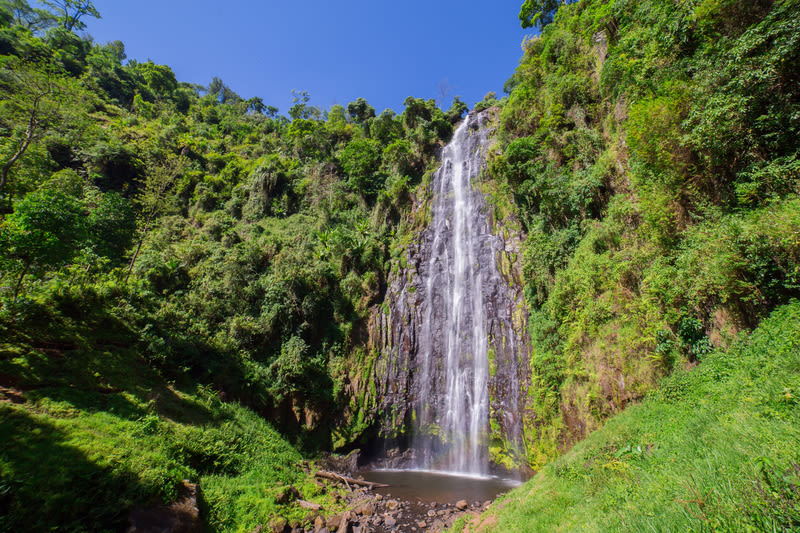Machame route at a glance
The Machame route is 62 km (39 mi) in total.
It starts its approach of the mountain from the southwest, at Machame Gate. From there, you trek steeply up through rainforest and then moorland to reach Shira Ridge, before crossing the wide-open Shira Plateau.
At Lava Tower you join up with trekkers hiking the Lemosho and Shira routes. You then drop down a little in altitude as you head to Barranco Camp, which sits under Kilimanjaro's Southern Ice Fields.
From here, you follow the route up Barranco Wall and then through Karanga Valley. When you reach Barafu Camp, you rest for a few hours before setting out at midnight to make your summit attempt.
Finally, after having hopefully reached the summit of Uhuru Peak, you descend all the way back down to the rainforest via the Mweka route.
A great pic of Lava Tower by our talented client Andrés
7-day Machame route overview
At Follow Alice we only offer the seven-day Machame route, as the six-day version is too risky from an acclimatisation point of view.
The Machame can be completed in six or seven days. The extra day on the seven-day itinerary takes place on the ascent, which allows for better acclimatisation (this refers to how well your body adapts to high altitude). You always want the best acclimatisation possible on a Kilimanjaro climb, as many trekkers don't make it to the summit because their bodies start breaking down from poor acclimatisation.
Further, climbing Kilimanjaro isn't a race. The Machame route is very beautiful, so it would be a shame to rush it.
In our experience, most people who have completed the right Kilimanjaro preparation are able to complete the seven-day Machame route with no real problems.
Breakdown of the Machame route
7-day Machame route in profile
The two graphs below show the elevation of the seven-day Machame route in profile – first in metres, then in feet.
Detailed route description
Map showing the seven-day Machame route on Kilimanjaro
Day 1: Machame Gate to Machame Camp
To start the trek you drive to Machame Gate where you're recorded in the register held by Kilimanjaro National Park. You then start on your journey by hiking through the rainforest to Machame Camp, which at 3,020 m (9,908 ft) above sea level is your first overnight stop.]
- Elevation: 1,640 m to 2,850 m
- Distance: 11 km (7 miles)
- Hiking time: 5-7 hours
- Habitat: Rainforest
A flat section of the Machame route in the rainforest
Day 2: Machame Camp to Shira Cave Camp
After an early breakfast, you climb up and out of the rainforest and into the heather and moorland zone. You cross many streams and walk over a plateau that leads to Shira Cave Camp. At this campsite you have a spectacular view of the Western Breach and its glaciers in the east. Today's hike lasts about five to six hours in total.
- Elevation: 2,850 m to 3,810 m
- Distance: 5 km (3 miles)
- Hiking time: 5-6 hours
- Habitat: Moorland
Day 3: Shira Cave Camp to Lava Tower to Barranco Camp
Today is a day to climb high and then sleep low. As such today's route consists of two parts: the hike up to Lava Tower, followed by the hike down to Barranco Camp.
Part 1 | Shira Cave Camp to Lava Tower
- Elevation: 3,810 m to 4,630 m
- Distance: 7 km (4 miles)
- Hiking time: 4-5 hours
- Habitat: Moorland
You hike for about five hours to reach the impressive rock formation called Lava Tower at 4,630 m (15,419 ft) above sea level. The tower is a real highlight on the Kilimanjaro trek.
Part 2 | Lava Tower to Barranco Camp
- Elevation: 4,630 m to 3,976 m
- Distance: 3 km (2 miles)
- Hiking time: 2-3 hours
- Habitat: Moorland and alpine desert
After lunch at Lava Tower, you head down to Barranco Camp. The descent takes about two to three hours. Barranco Camp is located in a valley below the Western Breach and imposing Barranco Wall.
On the way to Barranco Camp via the gorgeous Machame route
Day 4: Barranco Camp to Karanga Camp
- Elevation: 3,976 m to 3,995 m
- Distance: 5 km (3 miles)
- Hiking time: 4-5 hours
- Habitat: Moorland and alpine desert
Today's hike of four to five hours is all about acclimatisation. After an early breakfast, it’s time for you to conquer the Barranco Wall. Although it may look intimidating at first, most trekkers report the wall isn't as difficult as they anticipated. At the top of the wall you're above the clouds and have superb views of the Southern Ice Fields and the summit. The trail then winds up and down until you arrive at Karanga Camp, where you spend the night.
Group jump at the top of Barranco Wall!
Day 5: Karanga Camp to Barafu Camp
- Elevation: 3,995 m to 4,673 m
- Distance: 4 km (2 miles)
- Hiking time: 3 hours
- Habitat: Alpine desert
It’s getting real! You’re now very close to the summit and have some amazing views of the mountain during your ascent of three hours to the last base, Barafu Camp, which sits at 4,600 m (15,091 ft) above sea level. You go to bed early tonight as you'll be woken around midnight to start the long summit trek.
Day 6: Barafu Camp to Uhuru Peak to Mweka Camp
Today is summit day! This is the big push to the summit at nearly 6,000 metres above sea level. It requires grit and determination, but you can do it!
Part 1 | Barafu Camp to Uhuru Peak
- Elevation: 4,673 m to 5,895 m
- Distance: 5 km (3 miles)
- Hiking time: 6-8 hours
- Habitat: Alpine desert and arctic
Your guide wakes you up around midnight so you can begin your summit attempt, which many describe as the most mentally and physically challenging part of the whole Kilimanjaro climb. The route heads northwest into the dark night. After about six or seven hours you reach Stella Point on the crater rim at 5,685 m (18,651 ft) above sea level. It should be sunrise about now, and you continue for an hour or so on a sometimes snow-covered trail to reach Uhuru Peak at 5,895 m (19,341 ft), which is the very highest point in all of Africa!
Stunning view of the glacier from the summit
Part 2 | Uhuru Peak to Mweka Camp
- Elevation: 5,895 m to 3,068 m
- Distance: 12 km (7 miles)
- Hiking time: 6-8 hours
- Habitat: Arctic, alpine desert and moorland
After reaching the summit, you descend to Mweka Camp at 3,110 m (10,204 ft) above sea level. Here, you spend your final night on the mountain after having hiked for about 12 to 16 hours today!
Day 7: Mweka Camp to Mweka Gate
- Elevation: 3,068 m to 1,640 m
- Distance: 10 km (6 miles)
- Hiking time: 3 hours
- Habitat: Rainforest
Today you hike down the last bit of the trail to the foot of the mountain, where your driver is waiting for you. Time for a beer and celebration dinner!
Our opinion of the Machame route
We really like the Machame route because of its beauty, variety of scenery, and great acclimatisation profile (this refers to how well a route lets you adjust to every altitude jump). The seven-day version also has a decent summit success rate, which refers to the number of trekkers who manage to reach Uhuru Peak, the mountain's highest point.
With all of these positives in mind, it's easy to understand why the Machame route is one of the most popular Kilimanjaro ascent routes – possibly the most popular one (truly reliable stats are elusive). So the one possible downside of the route is that it can be relatively crowded, particularly at the higher campsites and when you must climb Barranco Wall.
Whilst it's undeniably a very beautiful Kilimanjaro climb, we usually recommend the Lemosho route over the Machame route. This is because the Lemosho is just as beautiful, yet less crowded. And you can do the Lemosho over eight days, which increases your chances of summiting. These two Kilimanjaro routes do, however, join together on the morning of Day 3, so it's actually only the first couple of days that are different. You can learn more in Lemosho vs Machame.
Finally, if you're fearful of heights, please note that the Machame route does lead you up Barranco Wall. For some this is quite daunting (though it does tend to look scarier from afar than it actually is). You might like to consider the Northern Circuit route if heights aren't your thing; to learn more, please read Northern Circuit vs Machame route.
What's the scenery like on the Machame route?
The Machame route is one of the most beautiful of the seven Kilimanjaro routes. You pass through extremely varied terrain the whole way up to the summit. In fact, you pass through five different climate zones: rainforest, grassland, moorland, alpine desert, and the arctic summit. For this reason you have a good chance of spotting some of Kilimanjaro's unique plants and exciting wildlife.
The trek also takes you past stunning natural features such as the volcanic plug known as Lava Tower and the dramatic cliff face that is Barranco Wall. It also stops over at locations that offer some of the best sunrises and sunsets on Kilimanjaro.
Giant groundsels are an iconic Kilimanjaro plant
How hard is the Machame route?
No Kilimanjaro climb is easy, so let's get that point settled out of the gate!
But you're doubtless wanting to know how hard the Machame route is in comparison to the other six routes. Well, it isn't easy to state how hard a route is, especially as the things that might make a Kilimanjaro climb 'hard' can vary from person to person.
Generally speaking, the Machame route is somewhere in the middle in terms of its difficulty. For starters, it's longer and has more ups and downs than many of the other routes. This means it requires more energy per day than do the other trails.
It's also important to note that while it's more physically demanding than most of the other Kilimanjaro routes, the seven-day Machame route has a good acclimatisation profile. This means the ascent trail is relatively gradual, and it also includes a day when you climb high and then sleep low, which is very valuable in helping the body to adjust healthily to a new elevation.
Note that you most definitely need to be physically fit to manage the Machame route. But if you train adequately and trek the seven-day route with a qualified and supportive mountain crew, you should be able to reach the summit.
Walking high up on the mountain on the Machame route
How busy is the Machame route?
The Machame route is one of the busiest of all the Kilimanjaro routes. It's a very beautiful and varied route and also offers good acclimatisation, so it attracts a lot of climbers each year.
Also, the fact that you can try to climb this route in just six days means that many budget Kilimanjaro operators use the Machame route.
What does the Machame route cost?
As of June 2024, the seven-day Machame route costs US$2,850 per person sharing a tent if you trek with us at Follow Alice. (It costs more if you request your own tent.) Please note that this package fee includes many things, like lodge accommodation the night before and the night after the climb as well as transport to and from the trailhead. Check out the full list of inclusions in our Machame package, which is nine days in total.
We also delve deeper into the topic of costs in How much does it cost to climb Kilimanjaro?
Follow Alice campsite
Explore more of Tanzania
If you want to add a little adventure onto the end of your Kilimanjaro climb, we recommend going on a Tanzania safari – you won’t find a better African safari! Or hop over the border into Uganda to trek with mountain gorillas. Alternatively, if you’ve limited time and budget, why not do one or two extra activities in the Kilimanjaro region like visit a Maasai village or a coffee farm? We can make it all happen for you if you'd like!
Materuni Waterfall is a popular half-day activity in the Kilimanjaro region
